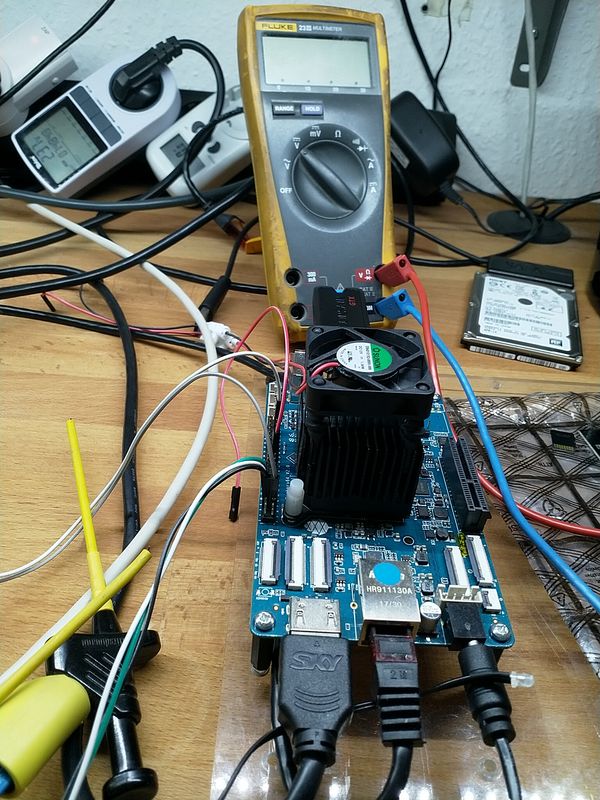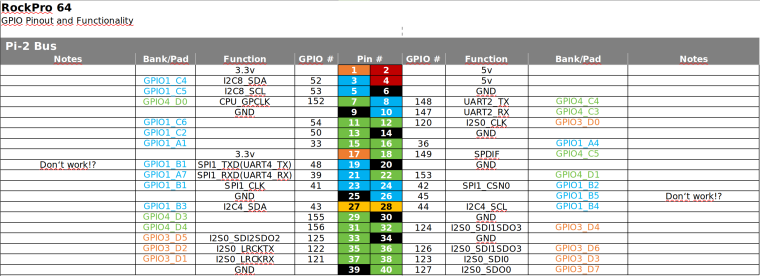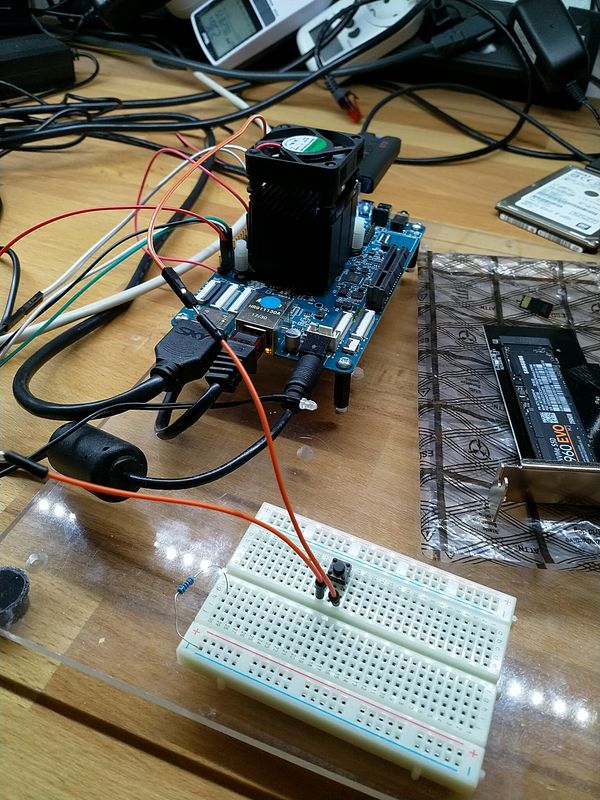Heute mal eine Bastelstunde und direkt vorne weg eine dicke fette Warnung!
Hiermit kann man seinen ROCKPro64 in Elektroschrott verwandeln! Ich hafte nicht für Schäden! Hirn einschalten vorher! 

Für den Rock64 gibt es ein Projekt das die RPi.GPIO cloned. https://github.com/Leapo/Rock64-R64.GPIO
A Python GPIO library for the Rock64 single-board computer (RPi.GPIO clone).
GPIO - was ist das? Wiki
Gut, damit läuft das aber nicht auf einem ROCKPro64, weil die Nummerierungen der Pins nicht passen. Aber dafür gibt es da draußen Leute, die sich solche Themen erarbeiten.
Quelle: https://forum.pine64.org/showthread.php?tid=6419&pid=40185#pid40185
Erstmal das Ergebnis 
Output Test R64.GPIO Module...
This channel (ROCK 52) is already in use, continuing anyway. Use GPIO.setwarnings(False) to disable warnings.
Testing GPIO Input/Output:
Output State ELSE: 1
Output State IF : 0
Output State ELSE: 1
Output State IF : 0
Output State ELSE: 1
Output State IF : 0
Output State ELSE: 1
Output State IF : 0
Output State ELSE: 1
Output State IF : 0
Output State ELSE: 1
Video
So, nun das Ganze mal von vorne.
Software
Wir brauchen Python
sudo apt-get install python
Danach laden wir das Projekt
git clone https://github.com/Leapo/Rock64-R64.GPIO
Wie oben schon geschrieben, passen die Pin Nummern nicht.
cd Rock64-R64.GPIO/R64
nano _GPIO.py
In dieser Datei ergänzen wir wie folgt.
# Define GPIO arrays
#ROCK_valid_channels = [27, 32, 33, 34, 35, 36, 37, 38, 64, 65, 67, 68, 69, 76, 79, 80, 81, 82, 83, 84, 85, 86, 87, 88, 89, 96, 97, 98, 100, 101, 102, 103, 104]
#BOARD_to_ROCK = [0, 0, 0, 89, 0, 88, 0, 0, 64, 0, 65, 0, 67, 0, 0, 100, 101, 0, 102, 97, 0, 98, 103, 96, 104, 0, 76, 68, 69, 0, 0, 0, 38, 32, 0, 33, 37, 34, 36, 0, 35, 0, 0, 81, 82, 87, 83, 0, 0, 80, 79, 85, 84, 27, 86, 0, 0, 0, 0, 0, 0, 89, 88]
#BCM_to_ROCK = [68, 69, 89, 88, 81, 87, 83, 76, 104, 98, 97, 96, 38, 32, 64, 65, 37, 80, 67, 33, 36, 35, 100, 101, 102, 103, 34, 82]
ROCK_valid_channels = [52,53,152,54,50,33,48,39,41,43,155,156,125,122,121,148,147,120,36,149,153,42,45,44,124,126,123,127]
BOARD_to_ROCK = [0,0,0,52,0,53,0,152,148,0,147,54,120,50,0,33,36,0,149,48,0,39,153,41,42,0,45,43,44,155,0,156,124,125,0,122,126,121,123,0,127]
BCM_to_ROCK = [43,44,52,53,152,155,156,45,42,39,48,41,124,125,148,147,124,54,120,122,123,127,33,36,149,153,121,50]
Das Ganze dann abspeichern.
Im Pfad rock64@rockpro64v_2_1:~/Rock64-R64.GPIO$ eine Datei anlegen test.py
#!/usr/bin/env python
# Frank Mankel, 2018, LGPLv3 License
# Rock 64 GPIO Library for Python
# Thanks Allison! Thanks smartdave!
import R64.GPIO as GPIO
from time import sleep
print("Output Test R64.GPIO Module...")
# Set Variables
var_gpio_out = 52
#var_gpio_in = 18
# GPIO Setup
GPIO.setwarnings(True)
GPIO.setmode(GPIO.ROCK)
GPIO.setup(var_gpio_out, GPIO.OUT, initial=GPIO.HIGH) # Set up GPIO as an output, with an initial state of HIGH
#GPIO.setup(var_gpio_in, GPIO.IN, pull_up_down=GPIO.PUD_UP) # Set up GPIO as an input, pullup enabled
# Test Output
print("")
print("Testing GPIO Input/Output:")
while True:
var_gpio_state = GPIO.input(var_gpio_out) # Return State of GPIO
if var_gpio_state == str(0):
GPIO.output(var_gpio_out,1) # Set GPIO to LOW
print("Output State IF : " + str(var_gpio_state)) # Print results
else:
GPIO.output(var_gpio_out,0) # Set GPIO to LOW
print("Output State ELSE: " + str(var_gpio_state))
sleep(0.5)
exit()
Was fehlt noch? Der Anschluß der LED. In meinem Beispiel ist die LED wie folgt angeschlossen.
- Plus(+) der LED an PIN 3 (GPIO1_C4)
- Minus(-)- der LED an Pin 39 (GND)
Zum korrekten Anschließen der LED empfehle ich die Lektüre dieses Beitrages!
Starten des Scriptes
Um das Script zu starten benutzt man
sudo python test.py
Ohne sudo bekam ich Fehlermeldungen.
Fazit
Es gibt da für mich einige Unbekannte bei dem Thema. Das wären
- Stimmt die Nummerierung, ist sie komplett?
- GPIO.setmode(GPIO.ROCK) ermöglichte mir dann mit 52 endlich was zu finden?
Wir brauchen eine vernünftige Auflistung der Nummern zu den PINs. Gibt es das ? Stimmen alle PIN-Nummern!?
Bitte dran denken, da kann man sich evt. den ROCKPro64 mit schrotten! Also schön vorsichtig!!
Danke an Allison und smartdave für die Arbeit!
Ach, fast vergessen. Ich hab von Python recht wenig Ahnung, macht aber Spaß weil man unkompliziert und schnell zu Ergebnissen kommt.





